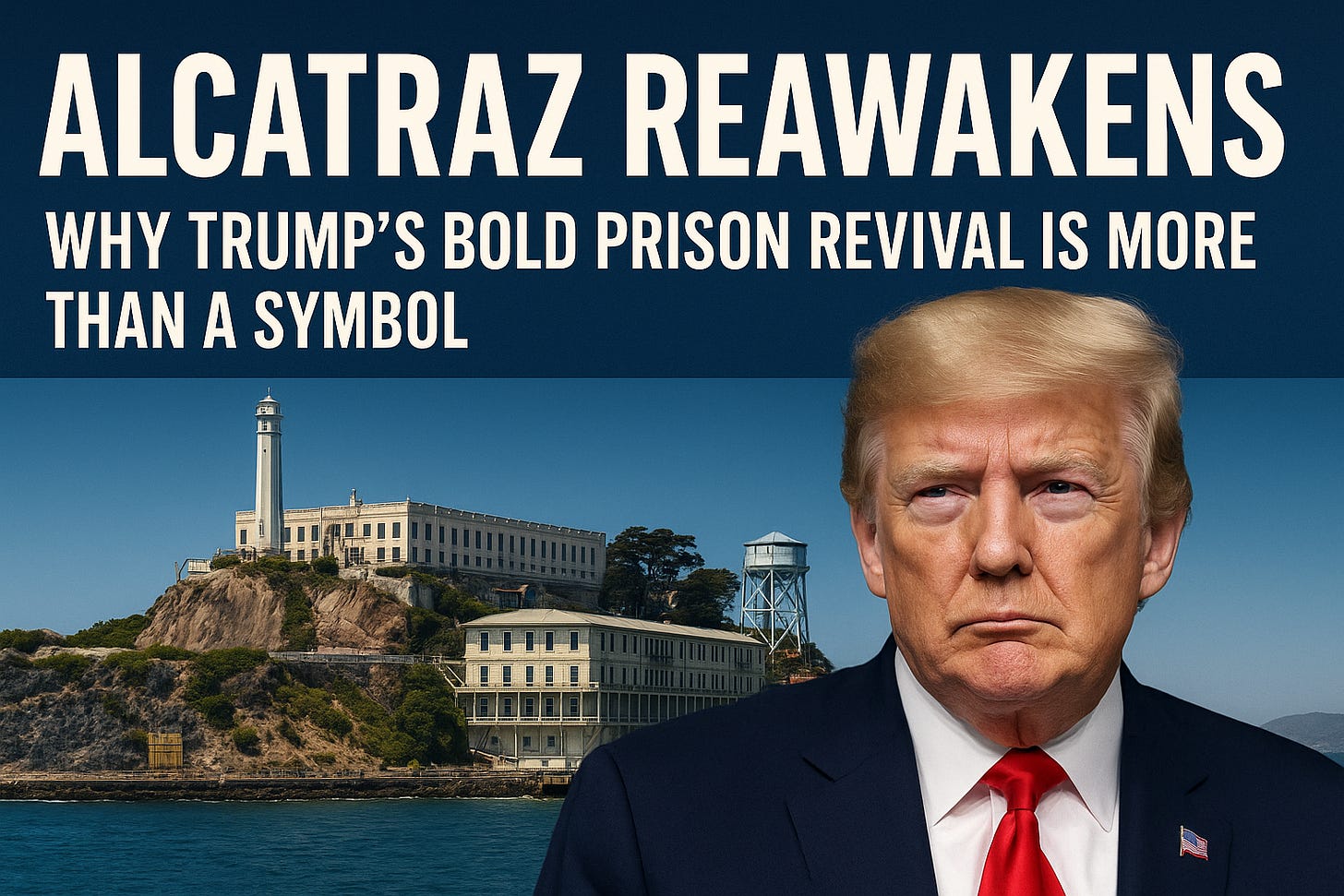Alcatraz Reawakens: Why Trump’s Bold Prison Revival Is More Than a Symbol
"When government forgets justice, the people remember."
That line could just as easily serve as the mission statement for President Donald Trump’s push to reopen Alcatraz, the infamous island prison that once held America’s most dangerous criminals. While critics scoff and pundits roll their eyes, Trump’s bold plan to modernize and reactivate Alcatraz is about more than symbolism—it’s a national wake-up call for law, order, and accountability in a country that has lost sight of all three.
The Case for Reopening Alcatraz: It’s Not Crazy—It’s Necessary
Let’s dispense with the media hysteria. The left says reopening Alcatraz is a “dumb idea,” a “PR stunt,” or “financially unfeasible.” But here’s the reality: America has a serious crime problem, and our federal prison system is buckling under the weight of red tape, woke policy experiments, and rising inmate violence.
When the Bureau of Prisons is dealing with a $3 billion backlog and activist judges are blocking deportations of violent criminals, it’s not insane to say we need a bold, secure, no-nonsense facility. It’s insane to pretend the status quo is working.
Trump’s Alcatraz proposal targets the most ruthless, violent, and unrepentant offenders—those who have no place in overcrowded, understaffed, and easily compromised mainland facilities. In short, it reintroduces a strong deterrent in an age of soft sentencing and revolving-door justice.
Pam Bondi’s Island Visit: A Signal of Serious Intent
When Attorney General Pam Bondi and Interior Secretary Doug Burgum visited Alcatraz on July 17, it wasn’t for a photo-op. It was a signal: Trump isn’t floating this idea for attention. He’s doing the groundwork. And when Trump says the “conceptual work started six months ago,” we believe him. He built a global real estate empire. He understands logistics.
Let the critics laugh. Let them call it “Alligator Alcatraz” or whatever they want. Trump is playing chess. They’re playing Twitter.
Cost? Let’s Talk About Value Instead
Yes, the cost of renovating or rebuilding Alcatraz is high—maybe $235 million to $1 billion, depending on how extensive the work is. But what price would the left put on public safety? Because right now, they seem comfortable spending $135 billion on a high-speed train in California that hasn’t laid a single mile of track.
Trump pulled the plug on Governor Gavin Newsom’s bloated “train to nowhere” last month, canceling $4 billion in federal funding. Could that money help fund Alcatraz? Legally, not yet—but symbolically? Absolutely.
Instead of shoveling billions into climate fantasies and infrastructure boondoggles, the Trump administration is saying: “Let’s spend that money protecting American lives.”
A National Landmark? Or a National Liability?
Some critics argue that reopening Alcatraz violates its status as a National Historic Landmark. That’s rich, coming from the same side that tears down statues, rewrites history, and repurposes national parks for homeless encampments.
If Alcatraz is more valuable as a tourist photo op than as a fortress against America’s worst criminals, we’ve truly lost the plot. Trump isn’t suggesting we erase history—he’s suggesting we give history new purpose.
Opposition From the Left? Predictable and Hollow
California Democrats like Nancy Pelosi and Gavin Newsom have predictably condemned the plan. Pelosi called it a distraction. Newsom cried federal overreach. But let’s remember—these are the same officials who oversaw the rise of crime-ridden cities, mass theft, cartel violence, and open-air drug markets.
If anything, their opposition is the strongest argument in favor of reopening Alcatraz.
They’re not afraid of the cost. They’re afraid of what it represents: a return to consequence in a society that has been programmed to excuse, justify, and ignore evil.
Immigration, Crime, and the Message Alcatraz Sends
Trump’s plan is about more than bricks and mortar. It's about drawing a line in the sand—and in the sea. Alcatraz is isolated, secure, and iconic. What better place to detain cartel enforcers, violent illegal aliens, and high-level federal offenders?
This isn’t about mass incarceration—it’s about targeted isolation for those beyond rehabilitation. It’s about saying: “There is a place for the worst of the worst, and it isn’t your neighborhood.”
Conclusion: Alcatraz Is the Reminder America Needs
Will Alcatraz ever reopen? Maybe. Maybe not. But that’s not the only point.
The very idea of bringing it back is a rebuke to the lawlessness, leniency, and ideological rot infecting our justice system. It reminds Americans that prisons are not supposed to be community centers. They’re supposed to protect us from those who refuse to live by civilized rules.
Trump’s Alcatraz revival—whether realized or not—forces a national conversation that’s long overdue:
Do we still believe in law and order?
Or are we content to let criminals run free while we debate virtue-signaling infrastructure and rename elementary schools?
Reopening Alcatraz isn’t just feasible—it’s philosophically essential.
Because a nation that cannot punish evil cannot preserve freedom.






Alcatraz prison closed primarily due to its high operating costs, which were nearly three times more expensive than other federal prisons.
The island's remote location necessitated expensive transportation of supplies, including fresh water, food, and fuel, by boat. Additionally, the prison's infrastructure was deteriorating and required significant and costly repairs.
Estimates to rehab range to from $235 million to $1.45 billion for initial renovations, with ongoing annual costs potentially reaching $40 to $100 million.
Just pissing our taxes away while people lose healthcare and kids starve.